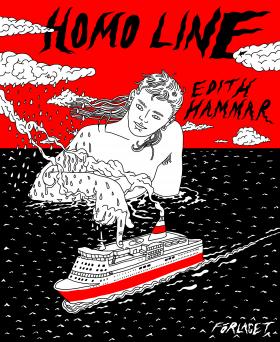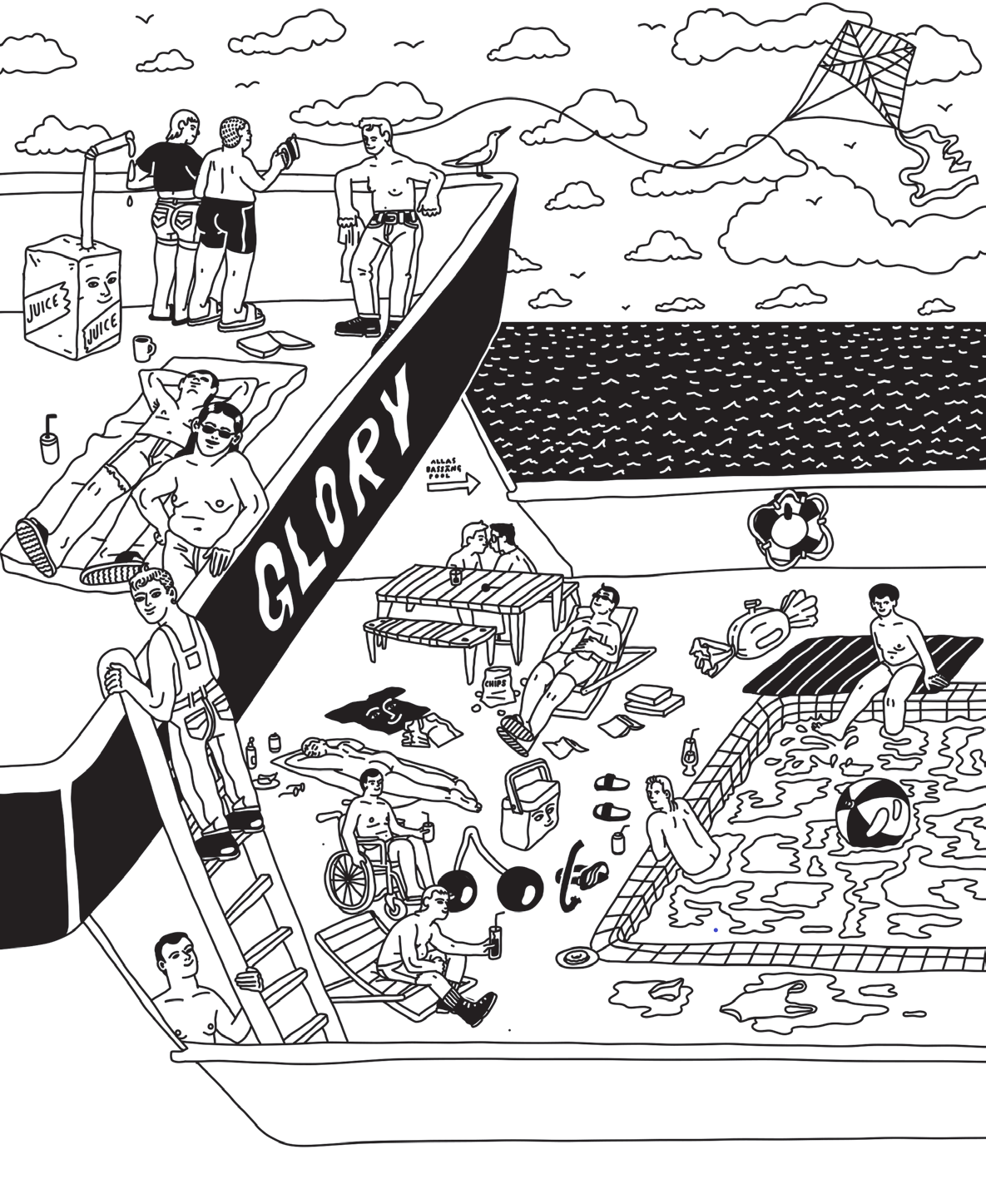
Homo Line
(Homo Line)
by Edith Hammar
reviewed by Darcy Hurford
The cheapest way of travelling between Sweden and Finland often involves a certain ferry company whose colours are white and red. Which, not at all coincidentally, are the colours on the cover of Edith Hammar’s graphic novel Homo Line. Inside, the story is in stark black and white. Like so many other ferries, airports and railway terminals around the world, Hammar’s Homo Line exists in a kind of liminal space – not actually in Finland, not actually in Sweden, but with elements of both. Hammar, a Finn who lived and studied in Sweden before returning to Finland, evokes and analyses feelings that will be familiar to anyone who’s lived life between two countries: homesickness, being an outsider, nostalgia, the fear that you could never move back and feel at home again – and is achingly honest about it. As well as being the author, they are also the book’s protagonist.
In the opening scenes, Hammar wakes up in the cabin, climbs out through the window and wades into the sea. Over the next few images, the proportions shift until finally we see them sitting in a bathtub, the ferry now a toy boat. From there we move through different memories of Helsinki and Stockholm and various ideas: how it feels to be a Finn in Sweden, how it feels to come back to your home town and feel like a stranger, inherited war trauma, homophobia, and why the recent film about Tom of Finland didn’t include gay men having sex by Stockmann’s department store during the blackouts in wartime Helsinki, even though it’s a valid part of history.
The spirit of Tom of Finland (the pseudonym of Touko Laaksonen, 1920-1991) saunters casually around Homo Line, referenced verbally as above, and visually elsewhere (clothing, romantic encounters, a poster on a bedroom wall). Laaksonen was one of Finland’s most successful – and influential – artists, producing iconic images of gay culture well before homosexuality was legalised (in 1967 in England and Wales, 1971 in Finland). Images with a utopian, fun quality: everyone’s unashamedly gay, everyone’s good-looking, everyone has a good time.
The same sense of fun is evident in Homo Line, even if the imagery is less idyllic. The grotty side of both Helsinki and Stockholm emerges quite clearly, and we see things you would step around carefully in real life if you saw them on the pavement. Here, though, the grottiness is humorous: a treacly-dark urine splash that grins wickedly from under a notice saying PLEASE DO NOT PISS HERE, a vomiting sculpture at the railway station, and a dagger-wielding ladybird smoking a cigarette. Sometimes these images are even imbued with a kind of lyricism, like the scene outside the (now-defunct) McDonald’s on Helsinki’s Iso Roobertinkatu: litter-strewn pavement, overflowing bins, mystery splashes on the windows – but the bins and streetlights have faces so it doesn’t look too grim. Gentrification means the McDonald’s is replaced by a vegetarian restaurant with well-groomed, tattooed staff: Hammar mourns its sticky floors while making it clear it was a horrible place. Nostalgia is complicated.

One of the charming things about Homo Line is the number of little details and inanimate objects with faces: mugs, a watering can, shoes, buildings, a soap bar, a chair back. Hammar has conversations with a beer can (lame chat-up lines) and a hot dog, kisses a tram and has a fight with that most iconic of Swedish souvenirs, a painted wooden Dalarna horse (the horse comes off worse). While some graphic artists divide the page into boxes, Hammar’s images fill up the whole space, sometimes extending right up to the edges of the page, as with some of the more psychedelic pictures of a Helsinki overrun with vegetation.
The story ends as it begins - back on board. To read the last few pages of the book, you have to turn it upside-down. The settings – the information desk, lounge, arcade games, deck – look familiar enough if you’ve ever taken a ferry, but there are certain differences in clientele and entertainments. In what feels like a last nod to Tom of Finland, we are finally sailing with Homo Line, a queered version of Viking Line, full of laidback-looking people enjoying themselves.

Homo Line
Förlaget M (Finland), 2020
180 pages
Foreign rights: The author holds the rights to the work, and can be contacted via the publisher.
Homo Line was awarded the Most Beautiful Book prize in the comic book category in 2020 by the Finnish Book Art Committee, an organisation representing printers, artists, universities and libraries. It was also nominated for Sarjakuva-Finlandia, the Finlandia prize for comic books.
